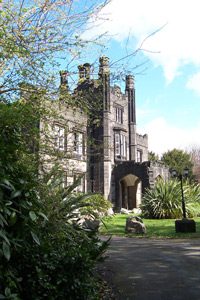THEY LIVED IN LEEDS
Thomas England (1797-1877)
Corn Factor - and his Castle

Not everyone knows that Headingley has a castle – not a medieval fortress, but a turreted, castellated early Victorian mansion, built by a wealthy businessman with pretensions to grandeur. Invisible from the road, it lies set back in spacious grounds along a tree-lined drive near the Original Oak pub.
It was built in 1843 for the wealthy corn factor, Thomas England, who came originally from Broughton near Skipton. He was one of the many businessmen who made themselves a fortune out of the urgent need to feed the exploding population of Leeds, in particular to supply the ever-growing number of mouths with that basic of life, bread. As a corn factor, he acted as a kind of middleman between the farmers, the importers of grain, and the merchants supplying the flour mills. He had his business in the Calls, with another branch in Wakefield, and every Tuesday from 11 until 1 he had his stand at the old Corn Exchange at the top of Briggate (not the Corn Exchange we know now, which was built later). The old Exchange had an open market square behind it, where the dealers all had their stands displaying samples of the grain they had on offer. The market was packed, business was thriving, and by 1836, in his late thirties and married with a growing family, Thomas England had made enough money to think about a move out of town to live in more pleasant, rural surroundings - but still close enough for daily travel to town in his private coach.
He bought a substantial plot of land from the Bainbrigge estate, on the edge of Headingley village fronting onto Headingley Lane, and employed a local architect, John Child, to design him a splendidly flamboyant house in Gothic style. With its tower, battlements and grandiose porch it lived up to the name he gave it: Headingley Castle. (He later changed it to ‘The Elms’ perhaps feeling he’d gone over the top!) The interior featured some fine decorative work, and an impressive full-height staircase hall, lit by a lantern with his own name and the architect’s inscribed around it – making sure that while the house stood his name would be remembered. And there were some innovative modern features: fire-proof cast iron beams in the basement, and a newly-invented boiler system to heat the house: the manufacturer proudly advertised that a model had been installed at Headingley Castle and could be viewed by application to Mr England.
He and his family lived there in some style. By 1851 his household, now with five children, included a governess, six women servants, and a groom and coachman living in separate quarters. He was clearly prospering, with financial interests in banking and the newly developing railways as well as his own business, and playing his part locally as a Trustee of the Leeds-Otley turnpike road.
His daughter Susan made an interesting marriage: in 1869 she married Thomas Clifford Allbutt, a physician at the Infirmary who went on to pursue a distinguished career, crowned with a knighthood. He invented the pocket clinical thermometer (previous models were a foot long!), undertook significant research in various specialisms, and published an important work on systems of medicine. A friend of the novelist George Eliot, he is said to be the model for Dr Lydgate in Middlemarch. He too had had a fine house built for himself in 1881, not a castle but in the style of an early manor house: Carr Manor, in Stonegate Road, Meanwood, built on the site of the seventeenth century Carr House.
When Thomas England retired he and his wife moved to their favourite resort of Cheltenham, where he died in 1877. Headingley Castle was sold in 1866 to Arthur Lupton, who came from a long-standing and distinguished Leeds family, and then from 1908 was occupied by Colonel Frank Fulford, who had made his fortune from the patent medicine Bile Beans. Later in the century it served as a centre for the blind, but is now converted into apartments (listed). Its blackened stone still retains something of the Gothic grandeur Thomas England planned 170 years ago for his magnificent Headingley retreat.
Eveleigh Bradford
November 2011